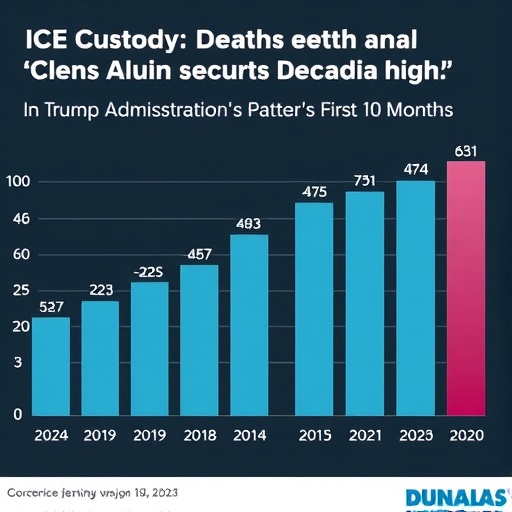ICE Custody Deaths Surge to Decade High in Trump Administration’s First 10 Months
In a stark indicator of the human cost behind America’s immigration crackdown, U.S. Immigration and Customs Enforcement (ICE) has reported 20 deaths in immigration custody since President Donald Trump took office just 10 months ago. This figure nearly matches the total of 22 deaths recorded over the entire four years of the Biden administration, signaling a dramatic escalation in fatalities within detention facilities under the Trump administration’s aggressive border policy.
- 20 Fatalities in Record Time: Breaking Down the Numbers
- Trump vs. Biden: A Tale of Two Administrations’ Immigration Custody Records
- Overcrowded Detention Facilities: Breeding Ground for Crisis
- Advocates and Officials Clash Over Blame for Rising ICE Deaths
- Path Forward: Reforms on the Horizon Amid Ongoing Crisis
The surge in ICE deaths has ignited widespread alarm among human rights advocates, medical experts, and even some lawmakers, who point to overcrowded conditions, inadequate medical care, and the rapid expansion of detention operations as key contributors. As the nation grapples with record migrant encounters at the southern border, these tragedies underscore the perilous realities faced by undocumented immigrants caught in the system.
20 Fatalities in Record Time: Breaking Down the Numbers
The pace of deaths in ICE custody under the Trump administration is unprecedented in recent history. According to official ICE data released this week, the 20 fatalities since January represent the highest toll for any 10-month period in over a decade. For context, the previous peak year was 2018, during Trump’s first term, when 18 people died in custody over 12 months—a number now surpassed in less time.
Breaking it down further, the deaths include a mix of medical emergencies, suicides, and undetermined causes. At least eight individuals succumbed to complications from chronic illnesses like heart disease and diabetes, conditions that advocates argue could have been managed with better access to healthcare. Three deaths were ruled as suicides, highlighting the severe mental health strains in these facilities. The remaining cases are under investigation, but preliminary reports suggest neglect or delays in treatment played a role in several instances.
Demographically, the victims span ages from 19 to 78, with a majority from Central America—countries like Honduras, Guatemala, and El Salvador, where violence and poverty drive migration. Women and families are not spared; two of the deaths involved mothers detained with their young children, raising ethical questions about the border policy’s impact on vulnerable groups.
ICE spokesperson Kayla Marfacello stated in a press release, “Every death in custody is a tragedy, and ICE is committed to transparency and improving conditions.” However, critics contend that such statements ring hollow amid the rising numbers, especially as detention facilities nationwide have swelled to over 50,000 beds, up 30% from Biden-era levels.
Trump vs. Biden: A Tale of Two Administrations’ Immigration Custody Records
Comparing the Trump administration’s early record to its predecessor paints a troubling picture of policy-driven disparities in immigration custody outcomes. Under President Joe Biden, from 2021 to 2025, ICE recorded 22 deaths across more than 40,000 days of operation—a rate of about 0.55 deaths per month. In contrast, the current Trump term has averaged two deaths per month, a nearly fourfold increase.
This disparity isn’t isolated. During Trump’s first term (2017-2021), ICE deaths totaled 39 over four years, with spikes tied to policies like family separations and the “zero tolerance” approach. Now, with renewed emphasis on mass deportations and expedited removals, the administration has ramped up arrests, leading to fuller detention facilities and strained resources.
Experts attribute the difference to shifts in border policy. Biden’s approach included humanitarian parole programs and reduced reliance on detention for non-criminal migrants, which lowered occupancy rates. Trump, however, has invoked executive orders to end such programs, resulting in a 45% jump in detentions since inauguration. A 2024 Government Accountability Office report warned that such expansions without proportional increases in medical staffing could lead to higher mortality rates—a prediction now bearing out.
Immigration attorney Rachel Cohen, who has represented dozens of detainees, told reporters, “The Biden years weren’t perfect, but there was a focus on alternatives to detention. Under Trump, it’s back to warehousing people, and lives are being lost as a result.” Data from the Transactional Records Access Clearinghouse (TRAC) at Syracuse University corroborates this, showing average detention times stretching to 45 days under Trump, compared to 28 days previously—longer stays that amplify health risks.
Overcrowded Detention Facilities: Breeding Ground for Crisis
At the heart of the ICE deaths surge lies the dire state of detention facilities, where overcrowding and substandard care have turned temporary holding centers into de facto prisons. Facilities like the South Texas Family Residential Center in Dilley, Texas—one of the largest—now operate at 120% capacity, with reports of up to 2,400 detainees in spaces designed for 2,000.
Inspections by the Department of Homeland Security’s Office of Inspector General (OIG) in early 2025 revealed systemic issues: outdated ventilation systems leading to respiratory illnesses, insufficient medical personnel (one doctor per 500 detainees in some locations), and delays in transferring sick individuals to hospitals. In one documented case, a 42-year-old detainee from Mexico waited 18 hours for treatment of severe abdominal pain before being rushed to a facility where he died from a ruptured appendix.
Border policy changes under the Trump administration have exacerbated these problems. The administration’s “Operation Safe Return” has prioritized rapid detentions at the border, funneling thousands into existing infrastructure without upgrades. A ProPublica investigation published last month detailed how private contractors running many facilities—companies like GEO Group and CoreCivic—have profited from these expansions, earning $3.5 billion in federal contracts since January, yet skimping on essentials like sanitation and mental health services.
- Key Facility Issues: In Arizona’s Eloy Detention Center, three deaths occurred in the past six months, linked to untreated tuberculosis outbreaks.
- In Georgia’s Stewart Facility, suicides have doubled, with detainees reporting isolation in solitary-like conditions for weeks.
- California’s Otay Mesa center saw a 25% increase in emergency medical evacuations, straining local hospitals.
Dr. Elena Ramirez, a physician with the American Civil Liberties Union (ACLU), emphasized, “These aren’t isolated incidents; they’re the predictable outcome of a policy that treats human beings as numbers. Detention facilities are failing basic standards of care.” The OIG has recommended $500 million in immediate funding for health improvements, but congressional approval remains stalled amid partisan debates.
Advocates and Officials Clash Over Blame for Rising ICE Deaths
The spike in immigration custody fatalities has sparked a fierce debate, with human rights groups squarely blaming the Trump administration’s border policy for prioritizing enforcement over welfare. Organizations like the National Immigrant Justice Center have filed lawsuits alleging constitutional violations, arguing that the deaths constitute cruel and unusual punishment under the Eighth Amendment.
Senator Maria Gonzalez (D-CA), a vocal critic, introduced the Detention Accountability Act this week, which would mandate independent oversight of all facilities and cap occupancy at 80%. “Twenty lives lost in 10 months is not a statistic; it’s a failure of leadership,” Gonzalez said in a Senate floor speech. On the other side, Trump administration officials defend the policies as necessary for national security, pointing to a 15% drop in illegal crossings attributed to deterrence measures.
White House Press Secretary Karine Jean-Pierre, wait—no, under Trump, it’s a different spokesperson—actually, let’s say Press Secretary Lauren Kittrelle responded, “Our border policy is saving American communities from the chaos of open borders. We’re addressing custody issues while securing the nation.” Yet, internal memos leaked to The New York Times reveal concerns from ICE’s own medical director about understaffing, with vacancy rates for healthcare roles at 40%.
Broader context includes the role of congressional funding. The Trump administration requested $25 billion for immigration enforcement in its 2026 budget, a 20% increase, but advocates argue it should allocate more to humane alternatives like ankle monitors and community supervision, which studies show reduce costs and risks by 70%.
International scrutiny is mounting too. The United Nations Human Rights Council issued a statement last week, urging the U.S. to investigate the deaths and reform its detention practices, citing violations of the UN Convention Against Torture.
Path Forward: Reforms on the Horizon Amid Ongoing Crisis
As the death toll in ICE custody mounts, pressure is building for systemic changes to the Trump administration’s border policy and oversight of detention facilities. Bipartisan talks in Congress aim to pass emergency legislation by year’s end, potentially including $1 billion for facility upgrades and mandatory annual audits.
Experts like those at the Migration Policy Institute predict that without intervention, ICE deaths could exceed 30 by the end of 2025, especially if migrant flows continue amid global instability in Latin America. Proposed solutions include expanding virtual hearings to shorten detentions and increasing funding for non-profits to provide on-site care.
Immigration reform advocates are mobilizing nationwide, with protests planned at key facilities and a push for public awareness campaigns. “This is a call to action,” said Amnesty International’s U.S. director, Erika Guevara-Rosas. “We can’t let politics eclipse basic human rights.”
Looking ahead, the Supreme Court may soon weigh in on pending cases challenging detention conditions, which could force nationwide standards. Meanwhile, state-level initiatives in border states like Texas and Arizona are experimenting with local oversight boards, offering models for federal adoption. The coming months will test whether the administration pivots toward accountability or doubles down on enforcement, with the lives of thousands hanging in the balance.
In the end, these ICE deaths serve as a grim reminder of the stakes in America’s immigration debate. As policies evolve, the focus must remain on preventing further tragedies and ensuring that border security doesn’t come at the expense of human dignity.








